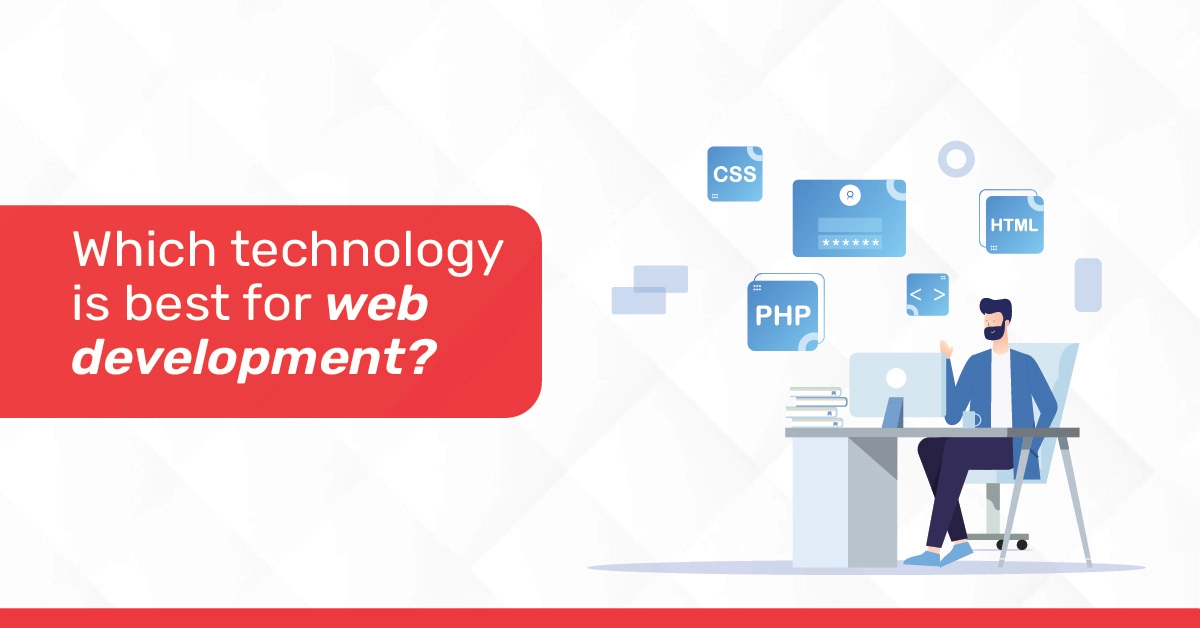Do you know that Web development is the foundation of the World Wide Web? This ranges from business-to-business applications to simple blogging sites… everything
Selecting the correct technology setup is one of the basics for having a well-organized, highly efficient, and easy-to-use Website or application. This decision depends on the project aims and objectives, available resources, time, and capital available.
Today, you will learn which web technologies are currently dominating the web development industry, focusing on practical examples, market share statistics, and recommendations.
Before starting….What Defines the “Best” Tech for Web Development?
The technology combination needs to match the project requirements. This is due to the importance of elements like maintainability, development speed, scalability, and performance.
To simplify, web development can be divided into three main categories:
Front-end Development: It is concerned with the graphical user interface and the interaction.
Back-end Development: It is not responsible for the UI and interacts with the back end and manages the server-side code and the interactions with the databases.
Full-stack Development: A single option that includes both front-end design and website coding.
Now it is time to look more closely at the technologies that are best suited to each area…
Front End Development Technologies
The term front-end development refers to all aspects of design that users come across on any website or an application. Key technologies in this space include:
1. HTML5 and CSS3
HTML5 is the standard for defining the structure of the content to be delivered, while CSS3 gives it style.
Why To Use Them?
These are the foundations of any web page and allow the newest layouts, media objects, and all types of responsiveness.
For example, The Guardian’s news website adopts the latest technology, including HTML5 for both mobile and PCs and CSS3 for dynamic designs.
2. JavaScript
An alternative language that can be used in integrating the different application elements, such as animation, sliders, and forms.
Why to Use It?
Javascript frameworks such as React.js, Vue.js, and Angular add functionality to web applications.
For example, Netflix—is an organization that barely makes use of Ajax but relies more on JavaScript for its near-flawless streaming abilities.
3. React.js, Vue.js, Angular
React.js: Recommended when developing engaging single-page applications (SPAs). Used by Facebook.
Vue.js: It is compact and can be quickly added to extensions, applications, and websites used by startups.
Angular: An all-in-one solution ideal for applications in large organizations such as Google Workspace.
Back-End Development Technologies
In the back end, there are elements such as a server, database, and API that manage the working of the web application. Here are some top back-end technologies:
1. Node.js
It is a runtime environment that is based on Chrome’s V8 JavaScript engine.
Why to Use It?
For the front end and backend, developers get to use JavaScript to help reduce development time.
For example, after making a transition to Node.js, PayPal managed to cut response time in half of its previous value.
2. Python (Django and Flask)
The Python frameworks are generally easy to use, and at the same time, they offer solid solutions.
Why to Use It?
Smaller applications are better suited for Flask, while larger applications are better suited for Django.
For example, the back end of Instagram is created with the help of Django.
3. Ruby on Rails
A framework that has been designed keeping the developer in mind and encourages a clean and maintainable code base.
Why to Use It?
Famous for MVP because of the time it takes in executing the process.
For example, Shopify developed its platform on the application Ruby on Rails.
4. PHP
A very popular language for scripting in web development.
Why to Use It?
Control more than 75 percent of the existing sites, and WordPress is included.
For example, Wikipedia’s content management system is based on PHP.
5. ASP.NET
A framework favored by Microsoft for creating highly scalable and business-level applications.
Why to Use It?
Makes it possible to connect tightly with other Microsoft appliances.
Areas of usage of ASP.NET are banking and healthcare.
Full-Stack Development
In Full Stack Development, there is no separation between client-side and server-side development…
Full-stack developers put technologies like MEAN (MongoDB, Express.js, Angular, Node.js) and MERN (MongoDB, Express.js, React.js, Node.js) into practice.
Modern companies like UberEats represent examples of companies that incorporate full-stack development to provide customers with reliable, efficient, and scalable products using the Node.js pattern for the back end and the React.js pattern for the front end.
Database Technologies
A database is a collection of stored information and data that is managed by an application.
Database selection is critical in terms of speed and capacity.
The grid structure is more rigid and harder to optimize. It is advisable not to disturb it by storing unnecessary files on the same drive as a database.
1. Relational Databases (SQL, MYSQL, PostgreSQL)
Recommended for dynamic data analysis tasks due to the capability for multiple and detailed queries to be run at once.
When it comes to scalability, MySQL is used by YouTube.
2. Nonrelations SQL Databases (MongoDB, Firebase)
In non-relational databases, the data model does not have to fit into the tabular structure.
The server application is most appropriate for extensive reading and writing tasks, like those presented by modern social media platforms.
The Twitter database is hybrid in that it uses both SQL and NoSQL databases.
New emerging technologies in web development
In order to maintain market leadership in web development, one must research new technologies….and maybe the next better technology.
1. Progressive Web Apps (PWAs)
It refers to web applications that are more like native applications by extending the thin-client web model.
The usage of Pinterest has increased by 60 percent since the company developed its PWA.
2. WebAssembly
Supports ‘performance-critical’ Web applications by executing compiled code within the browser space.
Online video editors like Figma depend mostly on WebAssembly’s performance.
3. Serverless Architecture
It uses cloud platforms like AWS Lambda or Azure to eliminate the need to deal with servers.
Slack is an example that enhances the cost and scale of the application by utilizing serverless.
DevOps and Version Control
There are many tools and practices for continuous deployment and scaling, such as Jenkins, Docker, Kubernetes, and others motivated by companies such as Etsy.
Git and GitHub make collaboration easier, improve the quality of work, and are great at proving teamwork by contributing to open-source projects.
Web Security Technologies
SSL and HTTPS
It encrypts data passed between users and the related servers.
It is used for trust and engagement, as well as the optimization of the SEO metrics.
Cloud Computing for Web Development
AWS, Azure, Google Cloud
Cloud platforms enable organizations to get fully functional and optimized architecture and effective and innovative instruments.
For example, Netflix relies on AWS for its global streaming service.
Conclusion
It is very important to understand that there is no universal approach to web development. The usefulness of any technology for a particular project depends on the objective, size, and what the users are likely to expect.
If there are front-end web frameworks that do a quick job in creating the interfaces seamlessly, there are back-end web frameworks like Node.js or Django with the ability to scale up and secure the websites in the best manner possible.
During the course of the study, new trends such as PWAs and serverless architecture offer new ways of improving performance and overall optimization.
If you evaluate your needs and choose the correct instruments, it’s possible to build useful Web solutions, which will be rather perspective.







